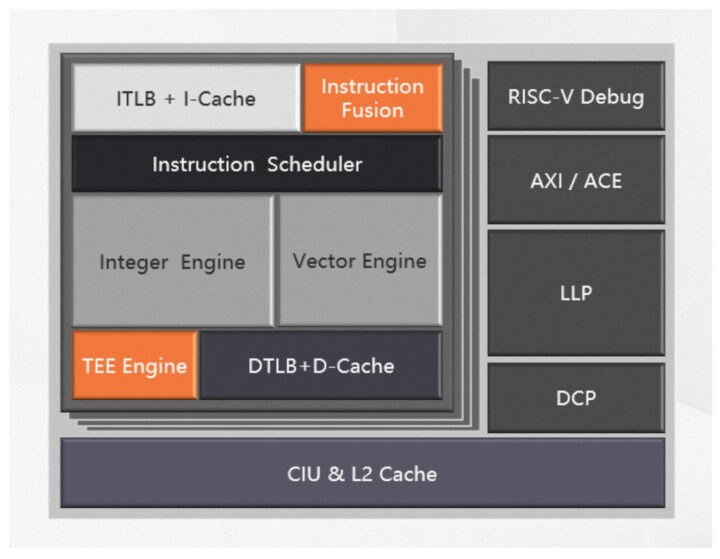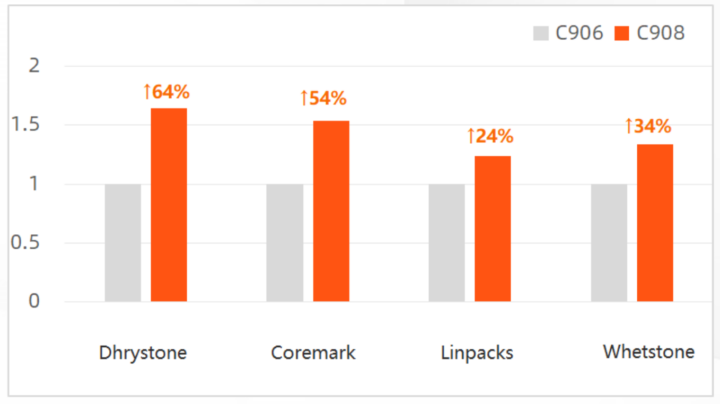We’ve seen two announcements of high-end RISC-V cores this week with the SiFive P670 and Andes AX65 processors each with a 4-way out-of-order pipeline, but Alibaba’s T-Head Semiconductor Xuantie C908 is a little different with a dual-issued, 9-stage in-order pipeline and support for the RISC-V Vector extension acceleration targeting mid-range AIoT applications.
The C908 64-bit RISC-V core adopts the RV64GCB[V] instruction and complies with the RVA22 profile for better compatibility with Android and other “rich” operating systems. The company says its performance is between the C906 and C910 cores introduced in 2020 and 2019 respectively.
- RV32GCB[V] 32-bit and RV64GCB[V] 64-bit RISC-V architectures with Bit manipulation and (optional) Vector operations extensions
- Support for RV32 COMPAT mode which allows for 64-bit RISC-V CPUs to run 32-bit binary code, and was merged into Linux 5.19.
- XuanTie extensions, including Instruction, Memory Attributes Extension (XMAE).
- RVA22 profile compatibility
- Cluster of 1 to 4 cores
- 9-stage dual-issue in-order pipeline
- Privileged modes – Machine, Supervisor, and User.
- Sv39/Sv48 virtual address system
- Two-level cache system to support hardware cache coherency and optional ECC.
- Bus interface – AXI4/ACE protocol with two optional interfaces: a Device Coherence Port (DCP) and a Low Latency Port (LLP).
- enhanced physical memory protection (ePMP) unit with up to 64 regions.
- RISC-V Debug and Platform-Level Interrupt Controller (PLIC) configurable with up to 1023 interrupt sources
The company also provides a performance comparison against the T-Head C906 single-issue in-order processor, albeit no data is provided showing how it compared to the higher end C910.
The C908 offers 24 to 64% performance improvement against C906 with synthetic benchmarks such as Linkpacks, Coremark, Whetstone, and Dhrystone. But we are not told anything about the manufacturing process and frequency of the cores under test, so the results may be meaningless, unless both cores used the same node and frequency.
Having said that, the XuanTie C908 can run at a frequency of up to 2 GHz and offers a dynamic power consumption as low as 52.8 mW/GHz per core using TSMC’s 12nm process. The energy efficiency of XuanTie C908 has been improved by more than 20% compared to that of XuanTie C906 in (undefined) typical scenarios under the same frequency and process constraints.
The RISC-V Vector Extension 1.0 really helps with AI workloads as the C908 is 2 to 3.5 times faster than C906, I’d assume under the same conditions, for wake word detection, image classification, keyword spotting, and anomaly detection in MLPerf tiny V0.7 inference performance test using the INT4 data type.
The new C908 core should eventually be listed on the T-Head website, but at this time, the only public information I could find was on the RISC-V blog.

Jean-Luc started CNX Software in 2010 as a part-time endeavor, before quitting his job as a software engineering manager, and starting to write daily news, and reviews full time later in 2011.
Support CNX Software! Donate via cryptocurrencies, become a Patron on Patreon, or purchase goods on Amazon or Aliexpress







